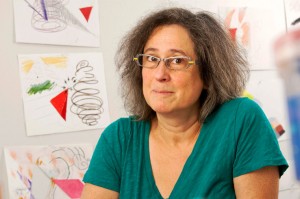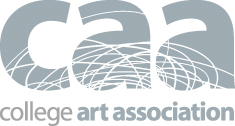Day one of CAA is finally here! I am sure we are all somewhere between hunting down our first cup of coffee and making our way to the Hilton for our first sessions of the day. I am eager to attend several opening sessions this morning but am finding myself even more excited to hear from our keynote this evening.
Leading up to CAA I sat down with Jessica Stockholder, artist and Chair of the Department of Visual Arts at the University of Chicago. Attending my first CAA conference, I was interested to learn from Jessica about CAA and her life as an artist in academia.
La Keisha Leek: As a first time attendee at CAA what are some of the things that I should expect from the conference?
Jessica Stockholder: CAA is a way for people to say hello to each other, people who teach particularly in art history but also in studio art. It’s also a job fair and networking tool. I haven’t experienced a lot of the papers but that part is a real treat!
LL: As an emerging art historian, who sometimes thinks like an artist, so it’s really interesting for me to not only see art historians deliver papers but see how artists are talking about their work alongside the presentations of art historians.
JS: Definitely some of the panels and events bring art historians, artists and critics together so you get an overlapping way of thinking about things
LL: How long have you been in arts education and what made you decide that education was something that you wanted to pursue?
JS: I think I was 35 and I was showing in New York a little bit and somebody from the School of Visual Arts (SVA) said, “you would be a good teacher” during a studio visit. So, she offered me a job and I taught in the undergraduate department. And then David Shirey in the graduate program offered me a job. I had just had a baby and I said, “well maybe in a year”, and he said, “you have to do it now!”, so I took the job. I was doing a little teaching at SVA and New York University (NYU). Jack Risley who was a classmate of mine at Yale, offered me the first job I had teaching a course at NYU and then I was wanting to leave New York. Somebody called and told me there was a job at Yale so I applied for that job because I was looking for a way not to be in New York – I didn’t want to be there my whole life. That was the first job I had that was a real job with a commitment to a place.
So I guess I didn’t decide I wanted to be an educator. I was and am an artist. Teaching is a more predictable way for an artist to earn money, but also its nice to have a foot in the education world and foot in the commercial world because the two encompass different sets of values and ways of thinking and talking. I took the Yale job when I turned 40. I think at that age if I hadn’t taken that job I would have gotten more set in my ways. I wouldn’t have needed to be looking at other people’s work as much and gotten more self-involved. Teaching is a really nice way to stay involved and see what younger people are doing, how the world is changing and what questions are being asked as time moves along. So, I really appreciate my students in that way and I learn a lot.
LL: That’s also something I learned for my instructors, which is that we teach them quite a bit. That makes me feel like I can do this and go in to education!
JS: It’s a nice place to explore things- whether you’re teaching or studenting!
LL: I agree! You’re giving the Keynote for CAA, are you excited? Do you have anything special planned?
JS: I definitely have something planned. I’m excited! It’s an honor and also daunting. But I’m going to talk about being an artist in academia and what my experiences have been.
LL: Awesome, I can’t wait! One last questions- are there any exhibitions up during CAA that you would recommend to conference attendees?
JS: Dieter Roelstraete’s show at the MCA The Way of the Shovel.
Day one of CAA is finally here! I am sure we are all somewhere between hunting down our first cup of coffee and making our way to the Hilton for our …


